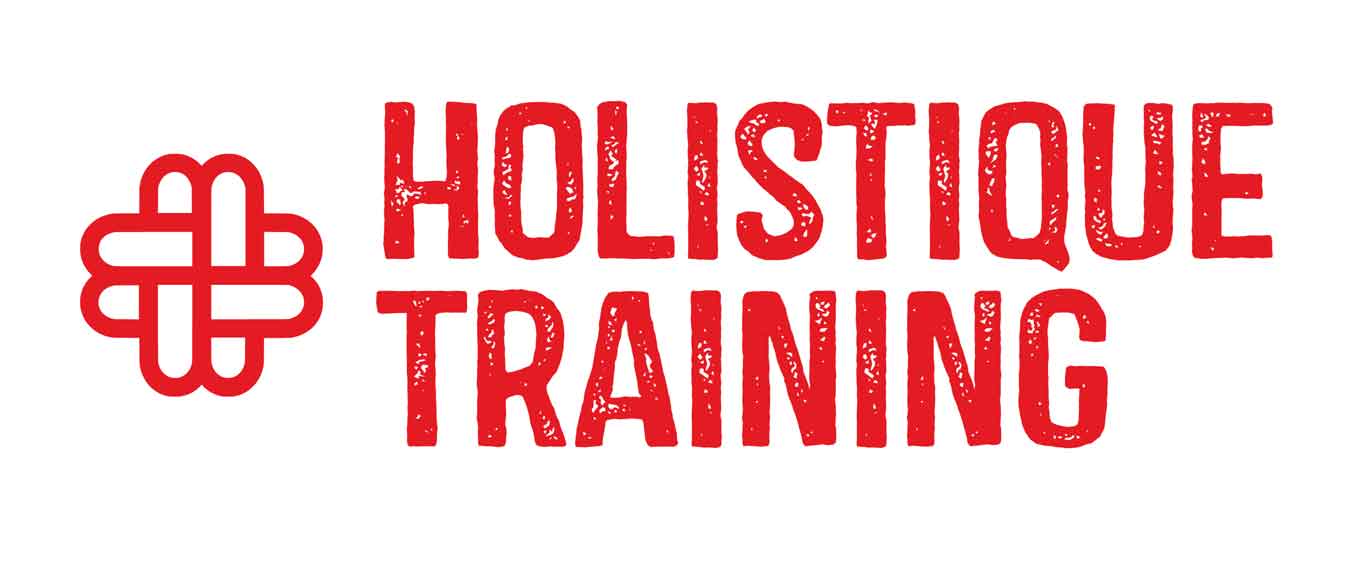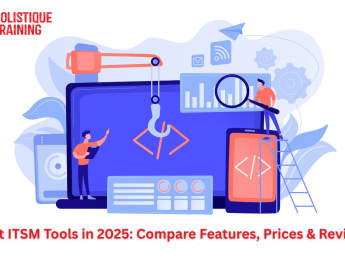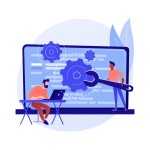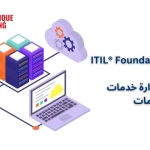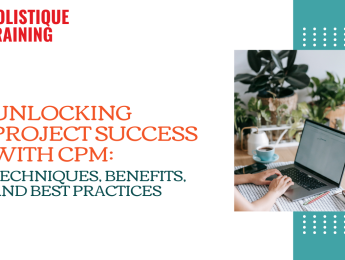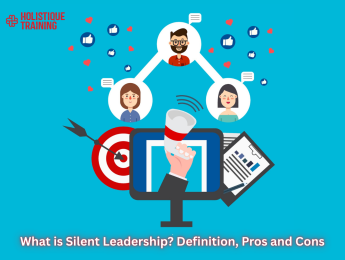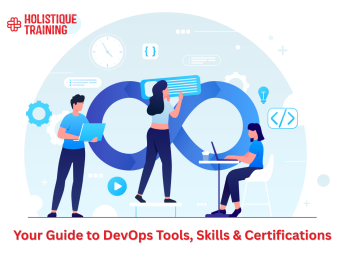Introduction
As digital infrastructures continue to expand, IT Service Management (ITSM) has become a cornerstone for businesses aiming to ensure efficiency, resilience, and customer satisfaction. Selecting the right ITIL-aligned tool can dramatically enhance service delivery, reduce downtime, and drive strategic growth. The ITSM market in 2025 is shaped by artificial intelligence, automation, and integrated digital experiences that prioritise both technical operations and end-user satisfaction. In this article, we will discuss the leading ITIL tools available today, their essential features, evaluation criteria, and how organisations can select the most appropriate solution for their needs.
What Is ITSM and Why It Matters in 2025
IT Service Management (ITSM) refers to the comprehensive set of processes and practices that organisations use to design, deliver, manage, and improve the way IT services are delivered to customers and internal stakeholders. Traditionally seen as a reactive helpdesk function, ITSM has evolved into a proactive and strategic discipline that supports business continuity and competitive advantage.
In 2025, several factors amplify the importance of ITSM:
- The Rise of Remote and Hybrid Work: With globally dispersed teams, businesses require consistent, seamless IT services across time zones and devices.
- Automation and Artificial Intelligence: AI-powered service desks now predict incidents, automate resolutions, and reduce response times, improving efficiency and lowering costs.
- Integrated Digital Ecosystems: ITSM platforms integrate with a wide range of business tools, from cloud infrastructure to customer relationship management (CRM) systems, fostering real-time data synchronisation and collaboration.
- Security and Compliance: As cyber threats become more sophisticated, ITSM platforms incorporate security frameworks to ensure regulatory compliance and safeguard sensitive information.
Ultimately, ITSM in 2025 serves as a strategic enabler of agility, innovation, and customer satisfaction, aligning IT operations with overarching business goals.
Key Features to Look for in an ITSM Tool
Selecting the right ITSM platform requires a careful examination of the specific capabilities that not only support technical operations but also enhance overall user experience and long-term scalability. The following features are essential for any modern ITSM solution in 2025:
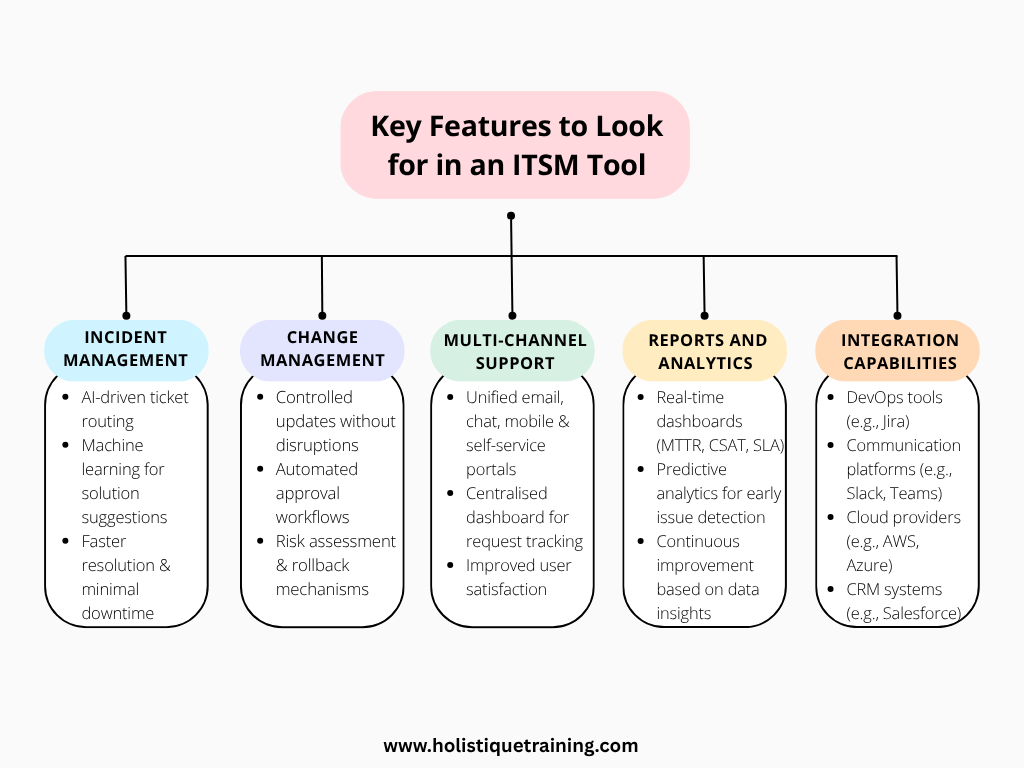
Incident Management
At the core of ITSM lies incident management — the ability to detect, log, categorise, and resolve service disruptions swiftly. Downtime can have serious financial and reputational consequences; hence, advanced ITSM tools now utilise AI-driven ticket routing to assign incidents to the most appropriate agent or team automatically. Furthermore, machine learning algorithms can analyse historical incident data to recommend the most effective resolutions, reducing time-to-repair and improving first-contact resolution rates. This proactive approach ensures that service disruptions are minimised and end-users experience minimal impact.
Change Management
In an environment of constant digital evolution, the ability to manage changes without compromising system stability is crucial. Effective change management modules allow organisations to implement infrastructure updates, software deployments, or configuration changes in a controlled and structured manner. Sophisticated ITSM platforms offer automated change approval workflows, risk assessments based on dependency mapping, and rollback mechanisms in case changes cause unforeseen issues. This balance between agility and stability safeguards business continuity while promoting innovation.
Multi-Channel Support
Modern employees expect flexibility in how they access support services. Whether submitting a request via email, engaging through live chat, logging tickets via mobile applications, or using integrated self-service portals, users demand convenience and accessibility. Leading ITSM tools unify these various communication channels into a centralised dashboard, enabling IT teams to track, prioritise, and resolve requests consistently regardless of the entry point. This omnichannel capability not only improves user satisfaction but also streamlines workload management for support teams.
Reports and Analytics
Data-driven decision-making has become fundamental to effective ITSM. Real-time analytics dashboards provide visibility into key performance indicators such as mean time to resolution (MTTR), customer satisfaction (CSAT) scores, SLA adherence rates, and backlog trends. These insights empower IT managers to identify recurring issues, measure team productivity, forecast resource needs, and make continuous process improvements. Additionally, predictive analytics can offer early warning signs of potential service degradation, enabling pre-emptive action.
Integration Capabilities
No ITSM tool operates in isolation. The ability to seamlessly integrate with a broader digital ecosystem is paramount. Leading platforms support integration with development tools like Jira for DevOps collaboration, communication platforms such as Slack or Microsoft Teams for real-time discussions, cloud service providers like AWS or Azure for infrastructure management, and CRM systems like Salesforce for customer-centric workflows. These integrations enable synchronised operations across departments, eliminate data silos, and foster cross-functional collaboration—essential in today’s interconnected digital enterprises.
Evaluation Criteria: How We Selected the Top Tools
Our selection of the top ITSM tools for 2025 was based on comprehensive evaluation across multiple criteria, ensuring both technical excellence and practical usability:
- User Experience: We prioritised platforms with intuitive interfaces that minimise training time and enhance productivity.
- Implementation Simplicity: Tools that offer rapid deployment, whether cloud-based or on-premise, alongside robust onboarding support, ranked highly.
- Pricing and Plans: Transparent, flexible pricing models that cater to different organisational sizes and needs were preferred.
- Customer Support: Platforms providing 24/7 support, multilingual services, and AI-powered assistance were favoured.
- Security and Compliance: Adherence to global security standards, data protection regulations, and advanced encryption were essential.
- ITIL Compatibility: Full or substantial alignment with ITIL v4 frameworks was a critical factor, ensuring standardised best practices.
The table below summarises these evaluation factors:
Evaluation Criteria | Description |
User Experience | Intuitive design, accessible UI across devices |
Implementation | Quick deployment with comprehensive onboarding |
Pricing Flexibility | Scalable plans with transparent pricing |
Customer Support | 24/7 multilingual support, AI assistance |
Security Standards | Compliance with GDPR, encryption, access control |
ITIL Alignment | Support for ITIL v4 processes |
The 10 Best ITSM Tools in 2025
1. ServiceNow
ServiceNow remains widely recognised as the gold standard for enterprise ITSM platforms. Its comprehensive suite covers every ITIL process, including incident, problem, change, asset, and configuration management, all integrated within a unified platform. What sets ServiceNow apart is its advanced AI-powered workflow engine, capable of intelligently routing tickets, predicting potential service disruptions, and recommending automated resolutions before incidents escalate.
The platform’s comprehensive Configuration Management Database (CMDB) provides full visibility into infrastructure dependencies, enabling proactive risk assessment during changes or outages. ServiceNow also offers industry-specific solutions tailored to healthcare, finance, manufacturing, and public sector needs, making it highly adaptable for complex environments.
Its expansive integration ecosystem allows seamless connections with tools such as Salesforce, Azure DevOps, and Zoom, ensuring real-time synchronisation across teams and platforms. Despite its premium price point, ServiceNow’s scalability, flexibility, and AI capabilities make it the preferred solution for global enterprises with intricate IT landscapes.
Best for: Large enterprises and multinational corporations.
Key Features: AI-driven incident management, predictive analytics, comprehensive CMDB, virtual agents, industry-specific solutions.
Integrations: Salesforce, Azure DevOps, Zoom.
2. BMC Helix ITSM
BMC Helix represents a new generation of ITSM platforms built entirely for the cloud. With its cognitive automation capabilities, BMC Helix leverages machine learning and AIOps (Artificial Intelligence for IT Operations) to proactively manage IT services. It predicts incidents, automates ticket handling, and analyses service patterns to optimise operational efficiency.
Its intelligent virtual agents and chatbots reduce human intervention in routine tasks, while multi-cloud support ensures flexibility for organisations operating across multiple cloud platforms. BMC Helix’s modern interface simplifies complex processes without compromising depth, making it suitable for enterprises seeking advanced automation in digital transformation initiatives.
The platform integrates easily with popular cloud providers and enterprise applications, including AWS, Microsoft Teams, and Oracle, facilitating smooth interoperability across departments and systems.
Best for: Automation-driven enterprises undergoing digital transformation.
Key Features: AIOps-powered service desk, chatbot services, predictive analytics, multi-cloud compatibility.
Integrations: AWS, Microsoft Teams, Oracle.
3. Freshservice (by Freshworks)
Freshservice stands out for its simplicity, affordability, and rapid deployment capabilities. Built with small to mid-sized businesses in mind, it provides out-of-the-box ITIL-aligned modules for incident, change, problem, and asset management. Its intuitive no-code workflow builder empowers non-technical teams to customise processes and automate repetitive tasks effortlessly.
Beyond traditional ITSM functions, Freshservice offers strong asset discovery, contract management, and SLA enforcement features. Its mobile-first design ensures IT teams and end-users can manage requests on-the-go, which is increasingly important in hybrid and remote work models.
Freshservice integrates seamlessly with collaboration tools like Slack, productivity platforms like Google Workspace, and identity management systems like Azure Active Directory, providing a highly connected experience for growing organisations.
Best for: SMEs and mid-market organisations seeking simplicity with strong ITIL compliance.
Key Features: No-code automation, asset management, contract tracking, mobile app support.
Integrations: Slack, Google Workspace, Azure AD.
4. Jira Service Management
Jira Service Management, part of Atlassian’s robust suite of tools, is tailored specifically for agile organisations, DevOps teams, and fast-paced software development environments. Unlike traditional ITSM platforms, Jira seamlessly integrates IT support processes with software delivery pipelines, promoting real-time collaboration between IT operations and developers.
Its features such as incident swarming, dynamic change calendars, and automated approval workflows make it ideal for organisations that embrace continuous deployment and frequent release cycles. Native integration with Atlassian’s Confluence knowledge base and developer tools like Bitbucket allow teams to share knowledge and resolve incidents collaboratively.
The platform’s flexibility and powerful DevOps integrations make Jira Service Management a natural choice for organisations aiming to bridge ITSM with agile methodologies.
Best for: Agile, DevOps, and software development teams.
Key Features: Agile-centric workflows, incident swarming, continuous delivery integration, real-time collaboration.
Integrations: Bitbucket, Trello, AWS Lambda.
5. Ivanti Neurons for ITSM
Ivanti Neurons combines cutting-edge automation, artificial intelligence, and self-healing technologies to deliver highly autonomous ITSM operations. By leveraging device telemetry and predictive analytics, Ivanti Neurons identifies potential issues before they escalate, triggering automated remediation workflows without human intervention.
Its low-code interface allows organisations to customise complex workflows and integrate business rules quickly. Ivanti Neurons also excels in security compliance, integrating IT operations with vulnerability management and endpoint protection—a critical feature for heavily regulated industries.
The platform offers deep integrations with infrastructure and security management tools such as SCCM, Active Directory, and Microsoft Intune, ensuring comprehensive visibility across networks.
Best for: Large-scale enterprises seeking intelligent automation and strong security integration.
Key Features: Predictive analytics, device telemetry, endpoint self-healing, low-code workflow customisation.
Integrations: SCCM, Active Directory, Microsoft Intune.
6. ManageEngine ServiceDesk Plus
ManageEngine’s ServiceDesk Plus offers a fully ITIL-compliant ITSM solution at an affordable price, making it attractive for budget-conscious organisations. It supports incident, problem, change, asset, and project management within a highly configurable platform that can be deployed on-premise or in the cloud.
The platform includes integrated remote control, service catalogue management, SLA tracking, and reporting tools, offering comprehensive functionality even for small teams. Its cost-effective pricing tiers and modular design allow organisations to scale features based on their growing needs.
ManageEngine integrates naturally with its broader Zoho suite and popular enterprise platforms like Microsoft Exchange and Zapier, streamlining cross-platform workflows.
Best for: Hybrid infrastructures, small-to-medium organisations with budget limitations.
Key Features: Full ITIL compliance, project management, asset tracking, remote desktop capabilities.
Integrations: Zoho, Microsoft Exchange, Zapier.
7. SysAid
SysAid delivers a straightforward yet powerful ITSM solution with a strong emphasis on automation, self-service, and flexibility. Its drag-and-drop form builders, custom workflows, and extensive automation rules simplify service desk operations, allowing teams to automate repetitive tasks easily.
It includes built-in remote control, chatbots for first-level support, and robust analytics to track service desk performance. SysAid is particularly popular with mid-sized organisations in healthcare, education, and government sectors due to its simple deployment and scalability.
With integrations to Google Workspace, LDAP, and SolarWinds, SysAid fits well within hybrid IT environments requiring efficient cross-system connectivity.
Best for: Mid-sized IT teams in healthcare, education, and government sectors.
Key Features: Drag-and-drop automation, built-in chatbots, remote desktop, service desk analytics.
Integrations: Google Workspace, LDAP, SolarWinds.
8. Zendesk for ITSM
Originally designed for customer support, Zendesk has extended its capabilities to internal IT service management. Its user-friendly interface, AI-powered ticket classification, and intuitive chatbot assistants make it especially appealing for non-technical departments and small service desks.
Although it may not offer full ITIL compliance for large-scale IT operations, Zendesk excels at simplifying request management and improving employee experience for routine support queries. It integrates well with sales, customer service, and e-commerce platforms, allowing businesses to unify customer and internal IT support.
Its ease of deployment makes it ideal for smaller organisations or non-technical teams needing simple, scalable ITSM functionality.
Best for: Start-ups, non-technical teams, and service-oriented organisations.
Key Features: AI-powered ticket classification, unified inbox, SLA monitoring, predictive chatbots.
Integrations: Shopify, Salesforce, GitHub.
9. TOPdesk
TOPdesk offers a modular, highly customisable ITSM platform particularly favoured by public sector institutions, educational organisations, and municipal governments. Its transparent pricing model, multi-language support, and facilities management modules extend its utility beyond IT, supporting non-technical service desks as well.
TOPdesk’s intuitive workflow templates simplify service request management, while its self-service portal empowers end-users to resolve common issues independently. Seamless integrations with business intelligence tools like Power BI allow IT leaders to gain deeper insights into service operations.
With on-premise and SaaS options, TOPdesk provides flexibility for organisations with diverse infrastructure needs.
Best for: Public sector, education, healthcare, and municipal institutions.
Key Features: Facilities management, multilingual support, workflow templates, self-service portals.
Integrations: Power BI, LDAP, SCCM.
10. HaloITSM
HaloITSM is a fast-emerging ITSM platform that offers enterprise-level features at a competitive price point. It includes full ITIL alignment with comprehensive service catalogues, contract management, SLA monitoring, and modern automation features.
The platform’s clean, user-friendly interface enables quick onboarding, while its customisable dashboards and service workflows ensure that organisations can tailor processes to their unique needs. HaloITSM’s strong customer support and rapid deployment make it increasingly popular among growing businesses and IT consultancies.
It integrates seamlessly with productivity platforms like Office 365, automation tools like Zapier, and collaboration platforms like Microsoft Teams, ensuring connected, efficient IT operations.
Best for: Fast-growing businesses, IT consultancies, and managed service providers (MSPs).
Key Features: Full ITIL compliance, contract management, SLA reporting, service catalogue automation.
Integrations: Office 365, Zapier, Microsoft Teams.
Comparison Trable
Tool Name | Core Features | Starting Price | ITIL Support | Key Integrations |
ServiceNow | AI workflows, CMDB | Custom Quote | Yes | Jira, Slack, Azure |
BMC Helix | AIOps, Predictive Analysis | Custom Quote | Yes | AWS, Microsoft 365 |
Freshservice | ITIL-ready, automation | £19/user/month | Yes | Slack, Jira, Zapier |
Jira Service Mgmt | DevOps integration | £21/user/month | Partial | Confluence, Trello |
Ivanti Neurons | Self-healing, low-code | Custom Quote | Yes | Azure, SCCM |
ServiceDesk Plus | ITIL modules, reporting | £10/user/month | Yes | Zoho, Microsoft AD |
SysAid | Automation, asset tracking | £12/user/month | Yes | Google Workspace |
Zendesk ITSM | Ticketing, chatbots | £25/user/month | Limited | Shopify, Salesforce |
TOPdesk | Modular, facilities management | Custom Quote | Yes | Power BI, LDAP |
HaloITSM | ITIL modules, easy UI | £29/user/month | Yes | Zapier, Office 365 |
Choosing the Right ITSM Tool for Your Business Needs
Selecting an ITSM solution depends heavily on organisational size, operational complexity, and available budget. Here are key considerations:
- Enterprise Scale: ServiceNow and BMC Helix excel for complex, global operations requiring extensive automation.
- Mid-Sized Budgets: Freshservice, ManageEngine, and HaloITSM provide cost-effective ITIL-aligned features for smaller organisations.
- DevOps Integration: Jira Service Management seamlessly bridges ITSM with agile development pipelines.
- Public Sector Focus: TOPdesk offers flexibility and transparency ideal for education and government sectors.
- Automation Priority: Ivanti Neurons and SysAid stand out for their automation capabilities and self-healing technology.
For additional comparisons, see Gartner's Magic Quadrant for ITSM Platforms.
Emerging Trends in ITSM for 2025 and Beyond
AIOps Integration
AI-powered monitoring and predictive incident resolution allow proactive service management, minimising disruptions and improving uptime.
Self-Service and Virtual Agents
Intelligent chatbots and self-service portals empower users to resolve common issues independently, reducing service desk load.
Experience-Driven ITSM
The shift towards experience-level agreements (XLAs) prioritises user satisfaction alongside traditional SLAs, focusing on service quality and employee engagement.
Sustainability and Green ITSM
Eco-conscious ITSM practices—like energy-efficient cloud deployments—align IT operations with ESG objectives, promoting sustainable growth.
Low-Code Hyper-Automation
Low-code platforms empower business users to customise and automate workflows quickly, enhancing agility in dynamic environments.
Cybersecurity Integration
Security features embedded within ITSM platforms now address vulnerability management, threat detection, and compliance monitoring directly within service operations.
Conclusion
Choosing the right ITSM tool is a strategic decision that can significantly impact operational resilience, service quality, and organisational agility. The landscape in 2025 demands platforms that combine automation, user-centric design, security, and scalability.
At Holistique Training, we offer expert-led training courses that prepare IT professionals to master modern ITSM tools and practices. Stay ahead of the curve by enrolling in our comprehensive ITSM certification programmes and transform your organisation into a proactive, agile enterprise ready to meet the challenges of the future.
